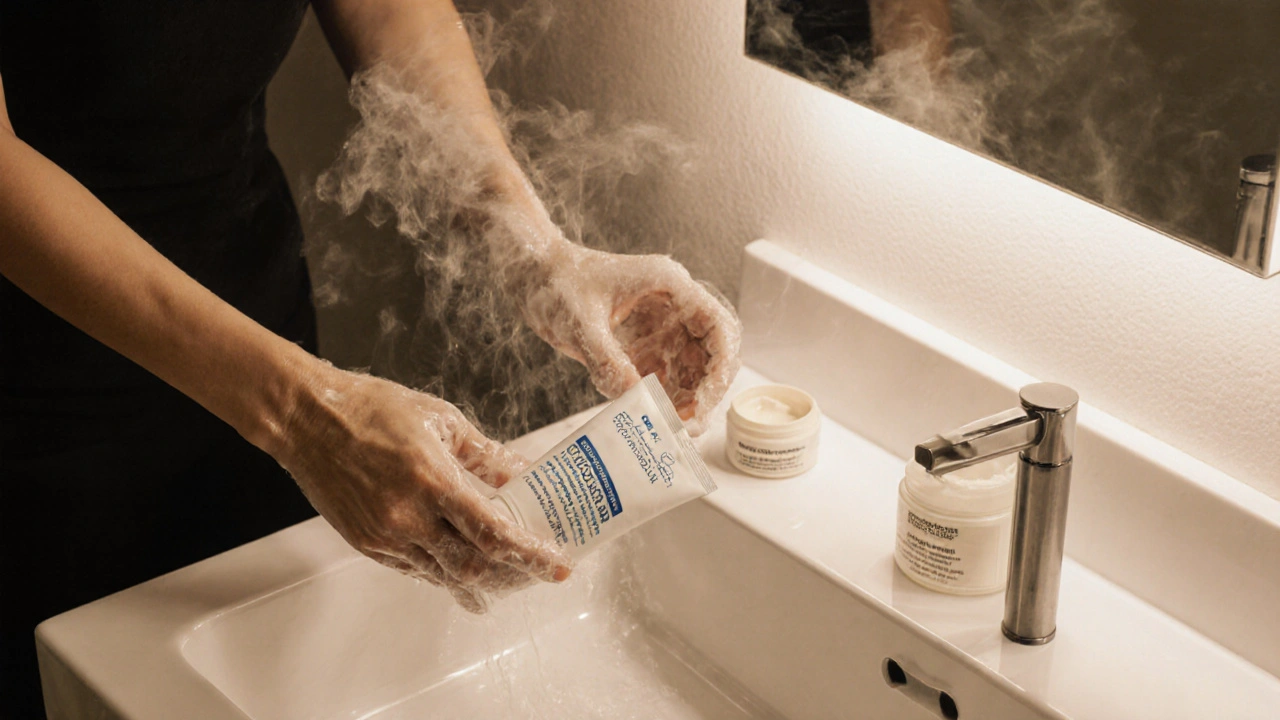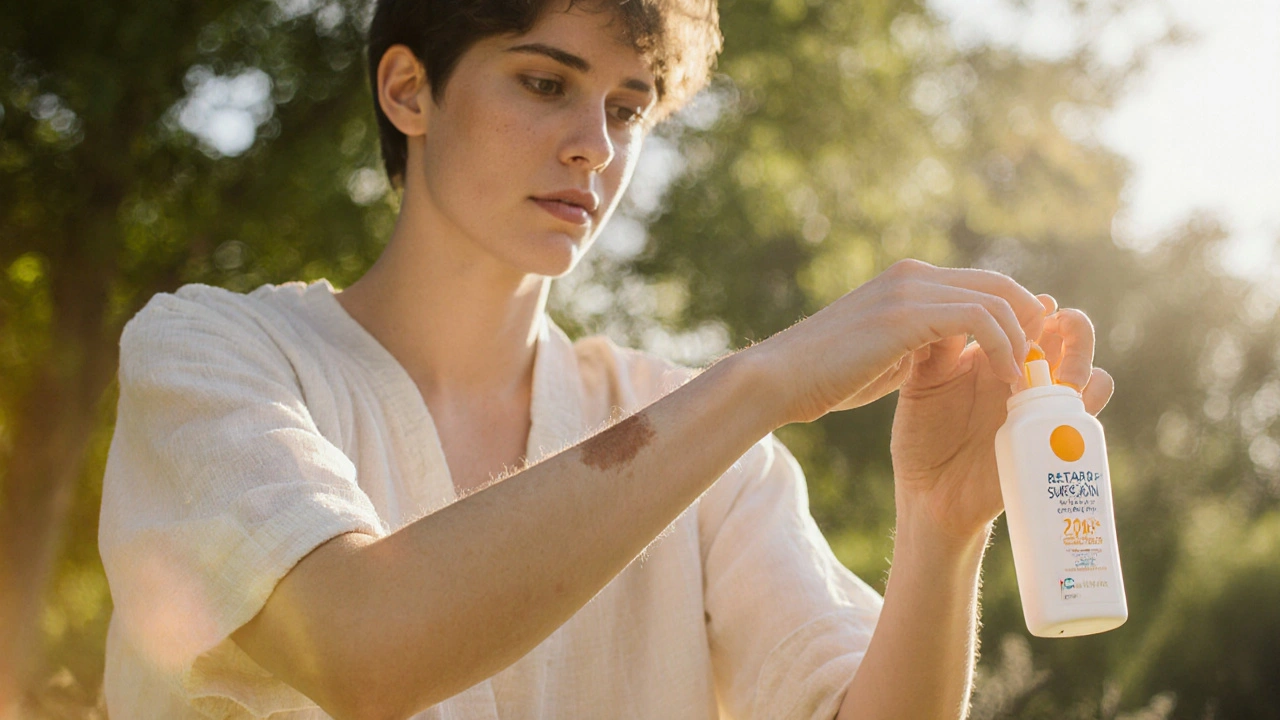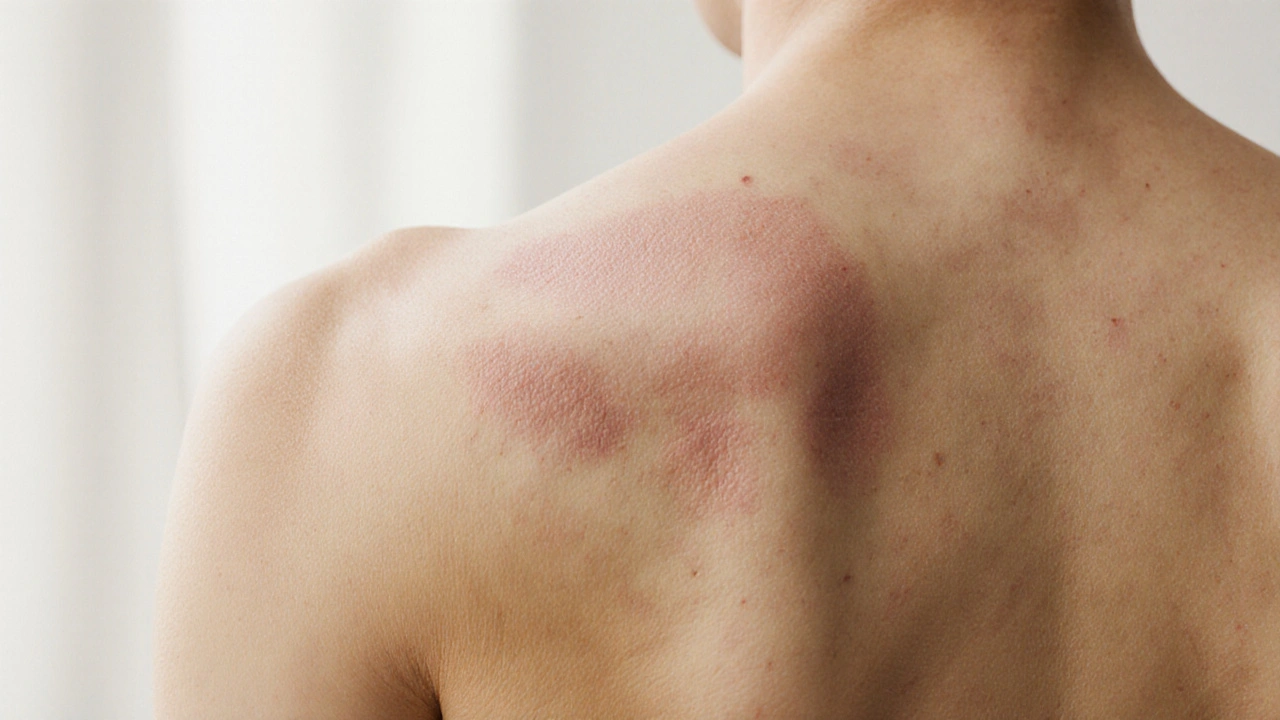Tinea Versicolor Treatment Selector
Enter your details and click "Find Best Treatment" to get personalized recommendations.
Antifungal Treatment Comparison
| Active Ingredient | Typical Use Frequency | Pros | Cons |
|---|---|---|---|
| Selenium Sulfide | 2-3 times/week | Effective for mild-to-moderate cases; inexpensive | May cause a temporary yellowish tint on dark hair |
| Ketoconazole | Daily for 2 weeks | Broad-spectrum, works quickly | Prescription required in many regions; possible skin irritation |
| Zinc Pyrithione | 2-3 times/week | Gentle, also treats dandruff; widely available in shampoos | May be less effective for severe infections |
If you’ve ever noticed patches of lighter or darker skin that seem to stubbornly resist any cream or wash, you might be dealing with Tinea Versicolor a common fungal infection caused by the yeast Malassezia. It’s not dangerous, but it can be frustrating, especially when the usual skin‑care products make the spots look worse. The good news? A carefully chosen routine can calm the fungus, even out your tone, and keep your skin feeling comfortable.
Key Takeaways
- Keep the skin’s pH slightly acidic (around 5.5) to discourage yeast growth.
- Use medicated cleansers or shampoos containing selenium sulfide, ketoconazole, or zinc pyrithione2‑3 times a week.
- Follow with a lightweight, non‑comedogenic moisturiser to restore barrier function.
- Sun protection is essential - UV can darken patches and make the contrast more noticeable.
- Seek a dermatologist if the condition persists after 4‑6 weeks of proper care.
What is Tinea Versicolor?
Tinea Versicolor appears as irregularly shaped patches that may be lighter, darker, or slightly pink. The fungus thrives in oily, warm areas - shoulders, back, chest, and sometimes the neck. Because the yeast feeds on skin oils, excessive sweating, humid climates, or oily skin products can worsen the breakout.
The condition is most common in teenagers and young adults, but anyone can develop it, especially during summer or after a heatwave. The spots often fade in winter when the skin produces less oil, only to flare up again in the heat.
How Your Skin‑Care Routine Impacts the Fungus
The right routine does two things: it reduces the amount of yeast on the surface and it prevents the skin barrier from becoming too dry or too oily - both scenarios can encourage growth.
Here’s why typical ingredients matter:
- pH balance: A slightly acidic environment (pH5-5.5) keeps Malassezia in check. Alkaline soaps can tip the scale in the fungus’s favor.
- Heavy occlusive moisturisers seal oil against the skin, creating a feeding ground for the yeast.
- Fragrances and harsh surfactants strip natural oils, prompting the skin to over‑produce sebum - a perfect snack for the fungus.
Balancing these factors is the cornerstone of an effective Tinea Versicolor skin care plan.

Step‑by‑Step Routine for Managing Tinea Versicolor
- Gentle cleansing - Use a mild, pH‑balanced cleanser once daily. Look for formulas that mention “skin‑protective pH” and avoid heavy fragrance.
- Medicated wash - 2‑3 times per week, replace the regular cleanser with a treatment shampoo or body wash containing one of the active ingredients listed in the comparison table below. Apply, lather, leave on for 5‑10 minutes, then rinse thoroughly.
- Targeted cream - After washing, apply a thin layer of a prescription or over‑the‑counter antifungal cream (ketoconazole 2% or clotrimazole 1%) to any remaining patches. Use it once daily for two weeks, then reduce to every other day for maintenance.
- Lightweight moisturiser - Choose a non‑comedogenic, oil‑free moisturiser to restore barrier function. Ingredients like ceramides, hyaluronic acid, and niacinamide are ideal.
- Sun protection - Broad‑spectrum sunscreen (SPF30 or higher) prevents UV‑induced hyperpigmentation, which can make patches look darker. Reapply every two hours when outdoors.
- Clothing choice - Wear breathable, natural fabrics (cotton, linen) that allow sweat to evaporate. Tight, synthetic garments can trap moisture.
Comparing Common Antifungal Agents
| Active Ingredient | Typical Use Frequency | Pros | Cons |
|---|---|---|---|
| Selenium sulfide | 2‑3times/week | Effective for mild‑to‑moderate cases; inexpensive | May cause a temporary yellowish tint on dark hair |
| Ketoconazole | Daily for 2weeks | Broad‑spectrum, works quickly | Prescription required in many regions; possible skin irritation |
| Zinc pyrithione | 2‑3times/week | Gentle, also treats dandruff; widely available in shampoos | May be less effective for severe infections |
All three agents disrupt the cell membrane of Malassezia, limiting its ability to reproduce. Choose based on severity, skin sensitivity, and whether you prefer an over‑the‑counter option.
Lifestyle Tweaks to Keep the Yeast at Bay
- Stay cool and dry - Use a fan or air‑conditioner in hot months, and shower promptly after exercising.
- Diet matters - High‑sugar and high‑fat diets can increase skin oil production. Opt for balanced meals rich in vegetables, lean protein, and omega‑3 fatty acids.
- Avoid oily cosmetics - Look for “oil‑free” or “non‑comedogenic” labels on sunscreens and makeup.
- Regular exfoliation - Gentle chemical exfoliants (6‑10% AHA/BHA) once a week help remove dead skin cells where the fungus can hide, but avoid over‑scrubbing.

When to See a Dermatologist
If you’ve followed a routine for four to six weeks and the patches haven’t faded, or if they spread rapidly, it’s time for professional help. A dermatologist can prescribe stronger oral antifungals or confirm that the discoloration isn’t something else, such as vitiligo or eczema.
During the visit, be ready to discuss:
- Current skin‑care products and their ingredients.
- Any recent changes in climate, diet, or stress levels.
- The frequency and type of antifungal agents you’ve tried.
They may also recommend a Wood’s lamp examination to highlight the affected areas more clearly.
Frequently Asked Questions
Can I clear Tinea Versicolor without medication?
Mild cases sometimes improve with diligent use of antifungal shampoos (like selenium sulfide) combined with a strict skin‑care routine. However, most people need at least a short course of medicated treatment to fully eradicate the yeast.
Will the patches return after treatment?
Recurrence is common, especially in warm, humid environments. Maintaining a low‑oil, pH‑balanced routine and using a maintenance shampoo once a month can keep flare‑ups at bay.
Is it safe to use the same antifungal shampoo on my scalp?
Yes. Many people treat both scalp dandruff and body Tinea Versicolor with the same selenium sulfide or zinc pyrithione shampoo. Just follow the recommended contact time for each area.
Can sunscreen make the spots darker?
Sunlight can increase melanin production in the unaffected skin, making the contrast more noticeable. Using a broad‑spectrum sunscreen prevents this, helping the color even out faster.
Should I avoid oily foods?
While diet alone won’t cure the infection, high‑glycaemic and greasy foods can boost sebum production, indirectly feeding the yeast. A balanced diet supports overall skin health.
Next Steps
Start by swapping your regular body wash for a selenium sulfide shampoo and pick a lightweight, oil‑free moisturiser. Stick to the routine for at least four weeks and monitor any changes. If you notice improvement, transition to a maintenance schedule (once‑monthly antifungal wash). If not, book a dermatologist appointment for a personalized plan.
Remember, consistency is key. The fungus isn’t going anywhere on its own, but with the right products and habits, you can keep it under control and enjoy an even skin tone again.


Comments (13)
Annie Crumbaugh October 6 2025
Tinea Versicolor can be annoying, but sticking to a simple routine helps. Using a pH‑balanced cleanser and a weekly selenium sulfide wash is a good start. Keep the skin moisturized with a light, oil‑free lotion and don’t forget sunscreen. It’s all about consistency.
Vic Harry October 6 2025
You gotta follow the schedule daily no excuses use the medicated shampoo twice a week and the cream every night
Suman Wagle October 6 2025
Ah, the fungal drama of the skin, how delightfully predictable. It’s almost poetic that a tiny yeast can hijack our confidence, yet the solution is as ordinary as a shampoo. Embrace the routine, because nothing says ‘I’ve got my life together’ like a weekly antifungal wash. If you keep at it, the patches will fade and you’ll be reminded that persistence beats the microbes.
Neil Sheppeck October 6 2025
Let’s remember that every skin type is unique, so mixing a gentle cleanser with a zinc‑pyrithione shampoo can be a game‑changer for many. I’ve seen friends with sensitive skin thrive when they swapped harsh soaps for a pH‑balanced wash, then topped it off with a lightweight moisturizer packed with ceramides. Adding a dash of niacinamide can calm any lingering redness, and the sunscreen acts like a shield against those stubborn dark spots. Feel free to experiment and share what works for you, the community grows stronger together.
Stephanie S October 6 2025
When dealing with Tinea Versicolor, it is essential, first and foremost, to maintain a slightly acidic environment, which discourages yeast growth; second, to incorporate a medicated wash, such as selenium sulfide, into your routine two to three times per week; third, to follow up with a non‑comedogenic moisturizer, rich in hyaluronic acid, to restore barrier function; lastly, never forget, a broad‑spectrum sunscreen, SPF 30 or higher, protects the newly evened skin from further discoloration.
Bradley Fenton October 6 2025
Try a gentle, fragrance‑free cleanser daily and a selenium sulfide shampoo twice a week; keep moisturiser light and oil‑free; sun protection is a must.
Wayne Corlis October 6 2025
It is truly astonishing how a microscopic yeast, barely visible to the naked eye, can orchestrate a full‑blown crisis of self‑esteem on the human epidermis, turning a perfectly ordinary back into a patchwork of discoloration. One might argue that the body’s own oil production is the villain in this narrative, yet the reality is far more nuanced, involving a delicate balance of pH, humidity, and even dietary choices. The guide rightly points out that a slightly acidic skin surface, hovering around a pH of 5.5, is the first line of defense, a fact that most of us overlook while reaching for the most fragrant cleanser on the shelf. Let us not forget, the humble selenium sulfide, a compound once relegated to dandruff shampoos, now emerges as a hero in the battle against Malassezia, proving that ordinary products can have extraordinary effects. While the guide suggests a frequency of two to three applications per week, the true art lies in observing one’s own skin’s response and adjusting accordingly, a principle that applies to countless dermatological regimens. Moreover, the inclusion of ketoconazole as a prescription‑only option underscores the necessity of medical supervision in severe cases, a reminder that self‑medication has its limits. The recommendation to pair antifungal treatment with a lightweight, oil‑free moisturizer is not merely cosmetic; it is a strategic move to prevent the skin from overproducing sebum, which would otherwise feed the fungus. Sunscreen, often dismissed as a vanity product, actually plays a pivotal role by preventing UV‑induced hyperpigmentation, which can accentuate the contrast between affected and unaffected skin. Lifestyle adjustments, such as wearing breathable fabrics and maintaining a balanced diet low in simple sugars, are presented not as optional tips but as integral components of a comprehensive plan. One could say that the guide attempts to democratize dermatology, turning what once required a specialist’s office into a DIY protocol accessible to the average person with an internet connection. Yet, sarcasm aside, the underlying message remains earnest: consistency is the cornerstone of success, and intermittent use will only prolong the ordeal. If patience is a virtue, then the humble weekly antifungal wash becomes a ritual of self‑care rather than a burdensome chore. In the grand scheme, these recommendations constitute a roadmap, not a rigid command, allowing each individual to navigate the terrain of Tinea Versicolor in a manner that respects their unique physiology. Ultimately, the battle against Malassezia is less about heroic interventions and more about the quiet, persistent steps taken day after day, a lesson that extends far beyond dermatology into the broader realm of personal wellness.
Kartikeya Prasad October 6 2025
I love how the guide blends science with a dash of humor – it’s like a skincare sitcom, and the characters are your pores 🎭. If you’re aiming for the gold standard, consider alternating selenium sulfide with zinc‑pyrithione shampoo; the former tackles the fungus head‑on, while the latter keeps dandruff at bay 😎. Remember to let the product sit for at least five minutes before rinsing, otherwise you’re just giving the yeast a lukewarm shower. A light, oil‑free moisturizer with ceramides will seal the deal, preventing the skin from overcompensating with oil production. And yes, sunscreen isn’t just a summer fling; it’s a lifelong commitment to keeping the newly even tone from turning into a sun‑kissed map 📍.
HARI PRASATH PRASATH October 7 2025
Clearly this skin issue is but a trivial footnote in dermatologial literature.
Andrew Miller October 7 2025
I watch the world fight fungus while I sit in the corner, feeling the itch of my own melancholy. The routine they describe feels like a distant echo to my own quiet suffering.
Brent Herr October 7 2025
People need to stop treating skin problems like a fashion statement and start taking responsibility for their hygiene. Ignoring the simple steps laid out in the guide is nothing short of negligence, and it reflects a broader disregard for personal health.
Julius Adebowale October 7 2025
Data shows that regular use of selenium sulfide reduces lesion count by 70% over four weeks. Minimal side effects observed.
KISHORE KANKIPATI October 7 2025
Embracing a balanced routine can turn the tide against Tinea Versicolor, and sharing our experiences creates a supportive community where everyone feels heard and empowered.